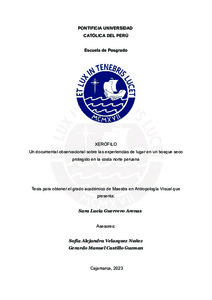| dc.contributor.advisor | Velázquez Núñez, Sofía Alejandra | |
| dc.contributor.author | Guerrero Arenas, Sara Lucia | |
| dc.date.accessioned | 2023-11-03T21:22:10Z | |
| dc.date.available | 2023-11-03T21:22:10Z | |
| dc.date.created | 2023 | |
| dc.date.issued | 2023-11-03 | |
| dc.identifier.uri | http://hdl.handle.net/20.500.12404/26353 | |
| dc.description.abstract | En un territorio bajo el control constante de diversos gobiernos a lo largo de la historia, personajes humanos y no humanos conviven en un escenario inhóspito. El documental tiene dos protagonistas que parecen confundirse: la naturaleza y la presencia humana. Sus texturas se combinan y lo uno no puede ser entendido sin lo otro. Los sonidos nos presentan personajes que no vemos, aves diferenciadas por sus cantos, vegetación que interpreta el aire sobre sus hojas y silencios que nos sumergen en un entorno árido. Las voces, corresponden a sus protagonistas y nos van presentando memorias, sensaciones, anécdotas y pasajes de una vida reinada por la capacidad de adaptarse no solo a un medio agreste, sino a los conflictos sucedidos en este espacio.
Xerófilo es producto de la presente investigación antropológica cuyo objetivo es analizar la construcción del espacio del bosque seco del Santuario Histórico Bosque de Pómac a través de diversas experiencias de lugar en el contexto de la realización de un documental con enfoque observacional y sensorial. A través de la descripción del espacio material del bosque, la explicación de las prácticas espaciales que se dan en y a través de dicho espacio, y la explicación de los sentidos de lugar que emergen de las diversas experiencias de lugar, el producto escrito complementa al audiovisual. Se concluye que el espacio del bosque seco del Pómac se construye a partir de experiencias de lugares disímiles, las cuales están determinadas por las historias de vida y las subjetividades de diversos personajes. | es_ES |
| dc.description.abstract | In a territory under the constant control of various governments throughout history, human and non-human agents coexist in an inhospitable setting. The documentary has two protagonists that can be confused: nature and human presence. Their textures combine and one cannot be understood without the other. Soundscape present us characters that we do not see, birds differentiated by their songs, vegetation that interprets the air on its leaves and silences that submerge us in an arid environment. The voices correspond to the protagonists and present us memories, sensations, anecdotes and passages of a life reigned by the ability to adapt not only to a rugged environment, but also to the conflicts that occurred in this space.
Xerophile is a visual product of the present anthropological research whose objective is to analyze the construction of the dry forest space of the Bosque de Pómac Historical Sanctuary through diverse experiences of place in the context of the realization of a documentary with an observational and sensorial approach. Through the description of the material space of the forest, the explanation of the spatial practices that occur in and through this space, and the explanation of the senses of place that emerge from the diverse experiences of place, the written product complements the audiovisual one. It is concluded that the space of the Pómac dry forest is constructed from various place experiences, which are determined by the life histories and subjectivities of diverse characters. | es_ES |
| dc.language.iso | spa | es_ES |
| dc.publisher | Pontificia Universidad Católica del Perú | es_ES |
| dc.rights | info:eu-repo/semantics/openAccess | es_ES |
| dc.rights | Atribución-NoComercial-SinDerivadas 2.5 Perú | * |
| dc.rights.uri | http://creativecommons.org/licenses/by-nc-nd/2.5/pe/ | * |
| dc.subject | Bosques--Perú--Ferreñafe (Lambayeque : Provincia) | es_ES |
| dc.subject | Santuarios--Perú--Ferreñafe (Lambayeque : Provincia) | es_ES |
| dc.subject | Películas documentales--Perú--Ferreñafe (Lambayeque : Provincia) | es_ES |
| dc.subject | Antropología visual--Perú--Ferreñafe (Lambayeque : Provincia) | es_ES |
| dc.title | XERÓFILO : Un documental observacional sobre las experiencias de lugar en un bosque seco protegido en la costa norte peruana | es_ES |
| dc.type | info:eu-repo/semantics/masterThesis | es_ES |
| thesis.degree.name | Maestro en Antropología Visual | es_ES |
| thesis.degree.level | Maestría | es_ES |
| thesis.degree.grantor | Pontificia Universidad Católica del Perú. Escuela de Posgrado | es_ES |
| thesis.degree.discipline | Antropología Visual | es_ES |
| renati.advisor.dni | 40924577 | |
| renati.advisor.orcid | https://orcid.org/0000-0003-1225-2486 | es_ES |
| renati.author.dni | 70615636 | |
| renati.discipline | 315117 | es_ES |
| renati.juror | Diez Hurtado, Antonio Alejandro | es_ES |
| renati.juror | Velázquez Núñez, Sofía Alejandra | es_ES |
| renati.juror | Castillo Guzmán, Gerardo Manuel | es_ES |
| renati.level | https://purl.org/pe-repo/renati/level#maestro | es_ES |
| renati.type | https://purl.org/pe-repo/renati/type#tesis | es_ES |
| dc.publisher.country | PE | es_ES |
| dc.subject.ocde | https://purl.org/pe-repo/ocde/ford#5.04.03 | es_ES |







